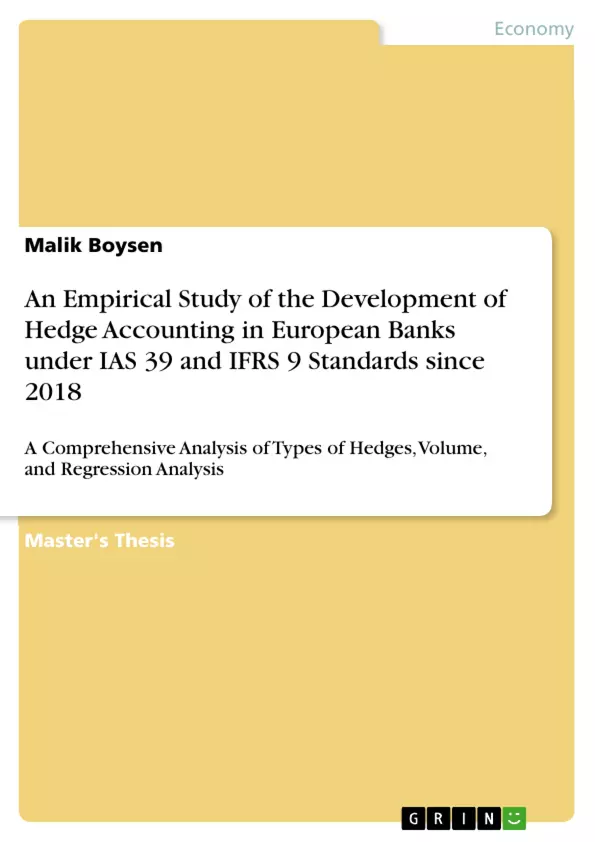The introduction of IFRS 9 has brought significant changes to hedge accounting practices in European banks, addressing limitations in the former IAS 39 standard. With three phases—classification, impairment, and hedging—IFRS 9 aims to better align financial reporting with risk management practices, particularly in hedge accounting. Despite the option to continue using IAS 39 for hedging, many banks have adopted IFRS 9 since its implementation in 2018. This study explores the development of hedge accounting since this transition, analyzing factors such as capital ratios and regional influences, and comparing the advantages of IFRS 9 to IAS 39. Through empirical analysis, it aims to assess the impact of the new standard on risk management and financial reporting in European banks.
Inhaltsverzeichnis (Table of Contents)
- 1 Introduction
- 2 Theoretical Framework
- 2.1 Explanation of hedge accounting and its importance for banks
- 2.2 Overview of IAS 39 and its limitations for hedge accounting
- 2.3 Explanation of IFRS 9 and its impact on hedge accounting
- 2.4 Comparison of IAS 39 and IFRS 9
- 2.5 Auditor review on the transition of banks to the application of IFRS 9
- 2.6 Summary of expectations
- 3 Methodology
- 3.1 Data collection process
- 3.1.1 Selection Procedure for the Sample
- 3.1.2 Procedure for Gathering relevant Data
- 3.1.3 Constraints on Data Resulting from Disclosure Quality
- 3.2 Description of the variables used
- 3.3 Description of data analysis techniques used
- 3.4 Explanation of the regression analysis and its importance
- 4 Empirical Results
- 4.1 Descriptive analysis and interpretation of the data collected since 2017
- 4.1.1 Qualitative reasons by supervised banks to switch to IFRS 9
- 4.1.2 Application of IFRS 9 with geographical analysis
- 4.1.3 Derivative-intensity, hedge intensity of transitioned banks and MFVH, MCFH
- 4.1.4 Development of hedge results in comparison with interest rates
- 4.1.5 Auditors of banks transitioned to IFRS 9 hedge accounting
- 4.1.6 Development of CET1 ratio for transitioned banks
- 4.1.7 Nominal amount of CCY and IRS derivatives
- 4.2 Regression analysis on the impact of switching to IFRS 9 hedge accounting in European Banks
- 4.2.1 Influence of country of residence
- 4.2.2 Influence of size
- 4.2.3 Influence of year
- 4.2.4 Influence of hedge-intensity
- 4.2.5 Influence of MFVH and MCFH
- 4.2.6 Influence of CCY swaps and IRS nominal
- 4.2.7 Influence of CET1 ration in 2022
- 4.2.8 Influence of Auditor
Zielsetzung und Themenschwerpunkte (Objectives and Key Themes)
This master's thesis empirically investigates the development of hedge accounting in European banks since 2018, focusing on the transition from IAS 39 to IFRS 9. The study aims to analyze the types of hedges used, their volume, and the overall impact of this regulatory change. * Impact of IFRS 9 on hedge accounting practices in European banks. * Analysis of the volume and types of hedging activities before and after the IFRS 9 adoption. * Examination of the relationship between IFRS 9 adoption and bank-specific characteristics (size, country, auditor). * Assessment of the impact of IFRS 9 on key financial ratios, such as the CET1 ratio. * Exploration of the role of different types of derivatives (e.g., interest rate swaps, currency swaps) in hedge accounting.Zusammenfassung der Kapitel (Chapter Summaries)
Chapter 1 provides an introduction to the research topic. Chapter 2 establishes the theoretical framework by explaining hedge accounting, comparing IAS 39 and IFRS 9, and outlining the expectations for the transition. Chapter 3 details the methodology, including data collection, variable descriptions, and the regression analysis approach. Chapter 4 presents the empirical results through descriptive and regression analyses, examining various factors influencing the adoption and application of IFRS 9 hedge accounting.Schlüsselwörter (Keywords)
Hedge accounting, IFRS 9, IAS 39, European banks, regulatory change, regression analysis, derivative instruments, CET1 ratio, financial reporting.- Arbeit zitieren
- Malik Boysen (Autor:in), 2023, An Empirical Study of the Development of Hedge Accounting in European Banks under IAS 39 and IFRS 9 Standards since 2018, München, GRIN Verlag, https://www.grin.com/document/1504523



